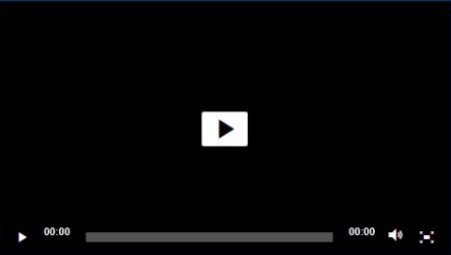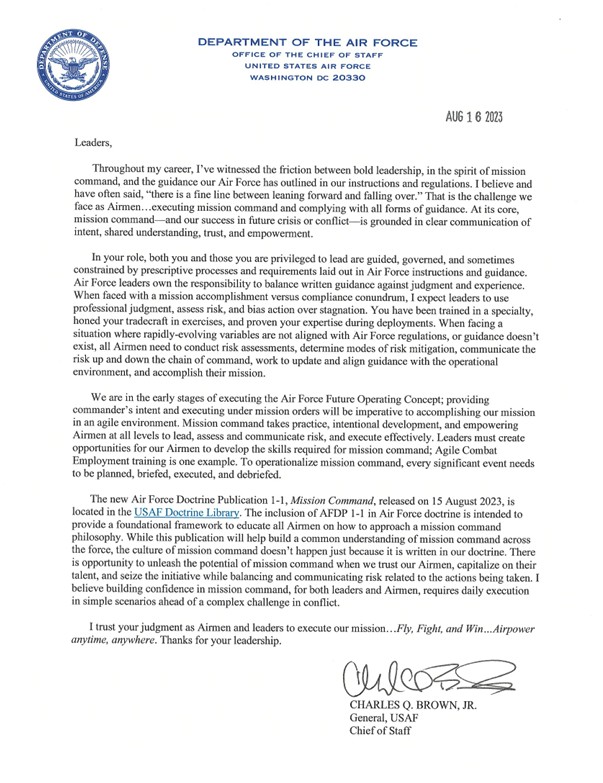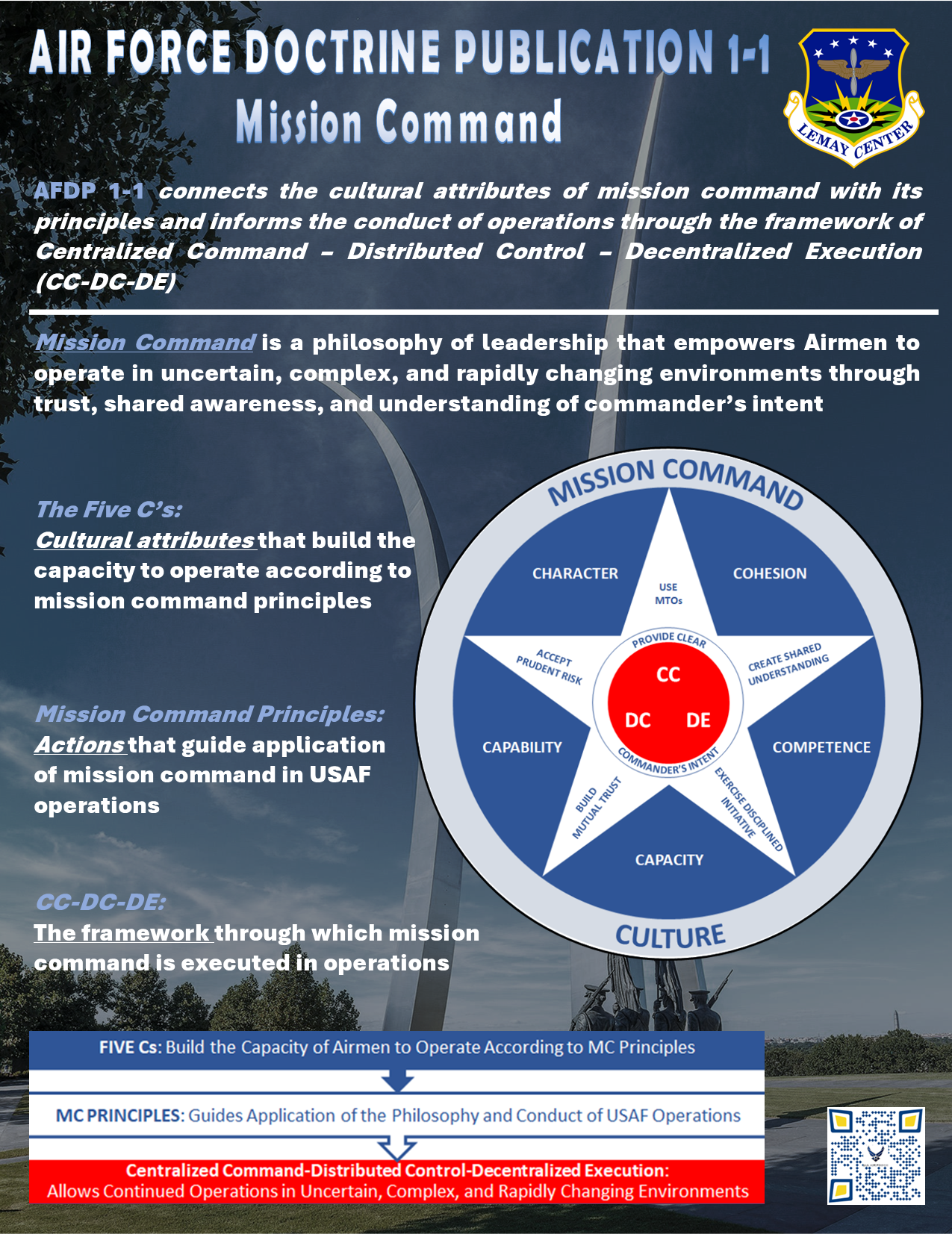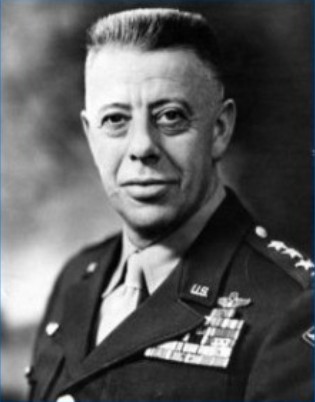.png?ver=evBqsGv8WOJO2NQrmlUb_A%3d%3d)
"I believe building confidence in mission command, for both leaders and Airmen, requires daily execution of simply scenarios ahead of a complex challenge in conflict." - Air Force General Charles Q. Brown

Mission Command is a philosophy of leadership that empowers Airmen to operate in uncertain, complex, and rapidly changing environments through trust, shared awareness, and understanding of commander's intent. To learn more about mission command, watch this 4-minute video and explore the resources listed below.



AF Doctrine Publication 1-1 Mission Command Memo Mission Command Overview
To learn more about how Mission Command affects you as a civilian in your particular position, talk with your supervisor or commander.

Air University's LeMay Center highlights General George C. Kenney as a Doctrine Paragon for his leadership and organizational command and control of the Far East Air Forces in the Southwest Pacific Area during World War II. His experience and solutions provide insights into some of the problems our Air Force is trying to solve today.
The Problem: General Kenney took command of the Allied Air Forces in the Southwest Pacific Ara in July of 1942. At the time, Japanese forces had pushed the Allies to the southern coast of Papua New Guinea and controlled a significant portion of the islands south of the Philippines. Allied forces were spread over a vast operation area, characterized by large expanses of ocean dotted with reefs and small jungle islands. General Douglas MacArthur, Supreme Commander of the Southwest Pacific Area, was dissatisfied with the performance of his air forces which struggles to gain air superiority and were fighting with inferior equipment to their Japanese counterparts. Eventually, General MacArthur's staff began giving direct orders to the air forces in the execution of operations. The effectively centralized all air campaign planning and execution functions at MacArthur's headquarters in Brisbane, Australia- over 1,000 miles away from the fight. Kenney realized significant change was needed to turn the tide in the skies over Papua New Guinea and push Japan back toward the Philippines.
The Solution: Kenney began by building trust with MacArthur and building relationships with MacArthur's staff. He also empowered his deputy commander, Brigadier General Ennis Whitehead, to plan and execute air operations from a forward location in Port Moresby, Papua New Guinea. Meanwhile, Kenney coordinated with MacArthur's staff and the Pentagon from his headquarters in Australia. To overcome difficulties with command and control (C2) over the larger operating area in the southwest Pacific, Geneal Kenney divided his forces into smaller units known as Air Task Forces (ATF). These ATFs were task-organized units, designed to accomplish a mission in a smaller part of the operating area. The ATFs were created with all necessary elements to complete a specific task, such as C2, ISR, strike, fighter escort, maintenance, engineering, and combat service support.
Kenney issues his ATFs mission type orders (MTO) with clear commanders' intent. He then empowered them to plan and execute the mission as they saw fit, all while coordinating with other ATFs nearby. Kenney's MTOs established a clear priority of effort for the ATF and the necessary supported and supporting relationships. Kenney's staff supported the ATFs by sharing relevant intelligence information and providing the ATF organic C2 and ISR assets to enable them to complete their missions. This allowed the ATFs in remote island locations to effectively fight against the Japanese in a dynamic and evolving theater with limited capability to communicate back to their headquarters. As a result, Allied Air Forces in the Southwest Pacific Area established air superiority and began interdicting Japanese forces in the area. This led to the "island hopping" campaign that ultimately allowed the Allies to retake the Philippines and enabled attacks on the Japanese mainland.
Why it Matters Today: Gen Kenney's leadership and C2 of allied air forces exemplifies the Air Force's Mission Command principles. His ATFs are an example of the Centralized Command-Distributed Control- Decentralized Execution (CC-DC-DE) C2 framework that is enabled by the Mission Command leadership philosophy. Kenney's ATF are the basis for the Air Force's most recent push toward a modern ATF force presentation model, which will create task organized teams that train and deploy together, to execute missions in dispersed and contested environments. Stay tuned as the LeMay Center is actively working to publish a new doctrine publication on ATFs this year.
For more information on General Kenney and concepts such as the ATF, check out the latest Air Force Doctrine Podcast episodes: "Deciphering Doctrine- Ep15-VCSAF General Slife on the Biggest Changes to the AF Since Its Inception: ATFs, AFFORGEN, MCA, Strategic Environment", and "Lessons Learned in Doctrine- Ep7-General Kenney: Leadership (Mission Command), C2, Air Task Forces, Relationships, and Logistics in the Pacific WWII", available at www.doctrine.af.mil and on iTunes, Spotify, Amazon Music, and DVIDS.
